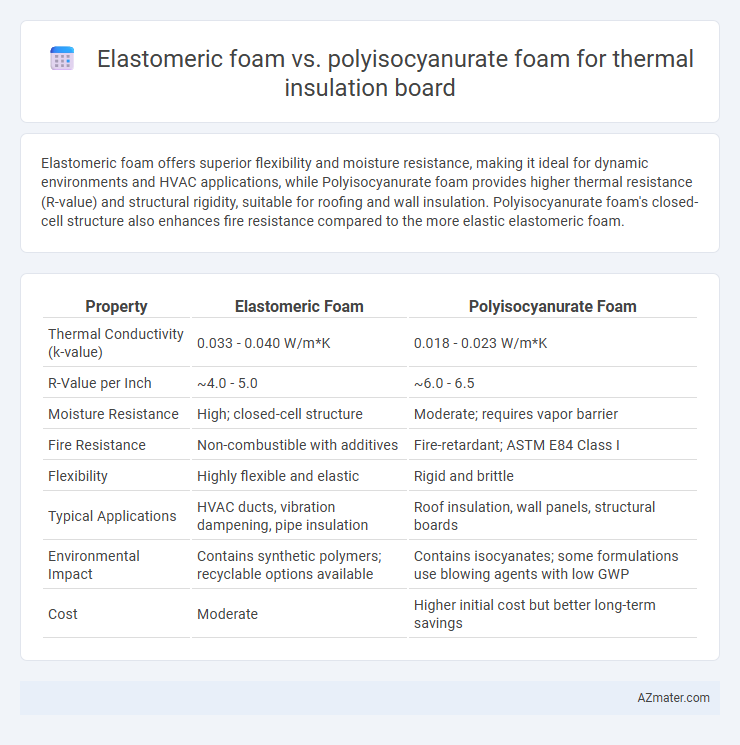Elastomeric foam offers superior flexibility and moisture resistance, making it ideal for dynamic environments and HVAC applications, while Polyisocyanurate foam provides higher thermal resistance (R-value) and structural rigidity, suitable for roofing and wall insulation. Polyisocyanurate foam's closed-cell structure also enhances fire resistance compared to the more elastic elastomeric foam.
Table of Comparison
| Property | Elastomeric Foam | Polyisocyanurate Foam |
|---|---|---|
| Thermal Conductivity (k-value) | 0.033 - 0.040 W/m*K | 0.018 - 0.023 W/m*K |
| R-Value per Inch | ~4.0 - 5.0 | ~6.0 - 6.5 |
| Moisture Resistance | High; closed-cell structure | Moderate; requires vapor barrier |
| Fire Resistance | Non-combustible with additives | Fire-retardant; ASTM E84 Class I |
| Flexibility | Highly flexible and elastic | Rigid and brittle |
| Typical Applications | HVAC ducts, vibration dampening, pipe insulation | Roof insulation, wall panels, structural boards |
| Environmental Impact | Contains synthetic polymers; recyclable options available | Contains isocyanates; some formulations use blowing agents with low GWP |
| Cost | Moderate | Higher initial cost but better long-term savings |
Introduction to Thermal Insulation Boards
Thermal insulation boards such as elastomeric foam and polyisocyanurate foam offer distinct advantages in building applications. Elastomeric foam provides excellent flexibility, moisture resistance, and sound absorption, making it ideal for HVAC systems and areas requiring vibration damping. Polyisocyanurate foam boasts superior thermal resistance with a high R-value per inch, enhanced fire retardancy, and structural rigidity, commonly used in roofing and wall insulation for energy-efficient buildings.
Overview of Elastomeric Foam
Elastomeric foam, a closed-cell insulation material, excels in thermal insulation due to its flexibility, moisture resistance, and ability to prevent condensation. Often made from synthetic rubber compounds like neoprene or nitrile, it offers superior durability and long-term performance in HVAC systems and refrigeration applications. Its thermal conductivity typically ranges from 0.031 to 0.035 W/m*K, making it an efficient option for energy conservation compared to rigid foams like polyisocyanurate.
Overview of Polyisocyanurate Foam
Polyisocyanurate foam is a rigid, closed-cell insulation material known for its high thermal resistance and superior fire retardant properties compared to elastomeric foam. It typically features a high R-value per inch, making it an efficient thermal insulation board for walls, roofs, and ceilings in commercial and residential buildings. Polyisocyanurate foam also offers excellent dimensional stability and moisture resistance, enhancing long-term energy efficiency and durability in various climate conditions.
Thermal Conductivity Comparison
Elastomeric foam typically exhibits thermal conductivity values ranging from 0.031 to 0.040 W/m*K, providing effective insulation with excellent flexibility and moisture resistance. Polyisocyanurate foam generally offers lower thermal conductivity, around 0.020 to 0.025 W/m*K, making it more efficient for thermal insulation in rigid board applications. The superior thermal performance of polyisocyanurate foam translates to higher R-values per inch compared to elastomeric foam, making it preferable for applications demanding maximum insulation efficiency.
Moisture Resistance and Water Absorption
Elastomeric foam demonstrates superior moisture resistance with a closed-cell structure that minimizes water absorption, maintaining insulation integrity and thermal performance in humid environments. Polyisocyanurate foam exhibits moderate water absorption but is more susceptible to moisture-related degradation over time, which can reduce its R-value and durability. Choosing elastomeric foam enhances long-term insulation efficiency in applications with high moisture exposure due to its robust resistance to water ingress.
Fire Resistance and Safety Performance
Elastomeric foam exhibits excellent fire resistance with low smoke generation and self-extinguishing properties, making it ideal for thermal insulation boards in safety-critical environments. Polyisocyanurate foam offers superior thermal insulation but can produce more toxic smoke and flame spread when exposed to fire without proper fire retardants. Selecting elastomeric foam enhances overall safety performance, especially in applications demanding stringent fire resistance standards.
Mechanical Strength and Durability
Elastomeric foam offers excellent flexibility and resilience, providing superior mechanical strength under dynamic stress and resistance to impact, making it ideal for applications requiring vibration dampening and frequent movement. Polyisocyanurate foam boasts higher compressive strength and long-term dimensional stability due to its rigid cellular structure, which enhances durability against deformation and mechanical loads in static conditions. The choice between these materials depends on the specific thermal insulation board requirements, balancing elastomeric foam's toughness and flexibility with polyisocyanurate's rigidity and endurance.
Installation and Application Differences
Elastomeric foam offers flexible, lightweight insulation ideal for curved surfaces and vibration damping in HVAC systems, while polyisocyanurate foam provides rigid, high R-value panels suitable for wall, roof, and floor insulation in commercial buildings. Installation of elastomeric foam is straightforward with easy cutting and adhesive application, enabling quick customization on-site, whereas polyisocyanurate requires precise cutting tools and mechanical fasteners for secure placement and enhanced structural integrity. The choice depends on application needs: elastomeric foam excels in duct insulation and moisture resistance, whereas polyisocyanurate is preferred for its superior thermal performance and fire resistance in envelope insulation.
Environmental Impact and Sustainability
Elastomeric foam offers superior flexibility and durability with a lower global warming potential due to its reduced reliance on blowing agents that harm the ozone layer, making it a more environmentally friendly option. Polyisocyanurate foam provides higher thermal resistance per inch, improving energy efficiency but involves petrochemical components and blowing agents that may contribute to greenhouse gas emissions. Selecting elastomeric foam enhances sustainability by prioritizing materials with better recyclability and reduced environmental toxins compared to traditional polyisocyanurate insulation boards.
Cost Analysis and Market Availability
Elastomeric foam insulation boards typically offer a moderate cost structure with competitive pricing due to widespread availability in HVAC and construction markets, making it a cost-effective option for thermal insulation. Polyisocyanurate foam boards tend to have higher upfront costs driven by superior R-value per inch and manufacturing complexities, but they provide enhanced energy efficiency and long-term savings on heating and cooling. Market availability of elastomeric foam is broader across residential and commercial sectors, whereas polyisocyanurate foam dominates in industrial and high-performance insulation applications, influencing cost dynamics based on supply chain and demand factors.

Infographic: Elastomeric foam vs Polyisocyanurate foam for Thermal insulation board
 azmater.com
azmater.com